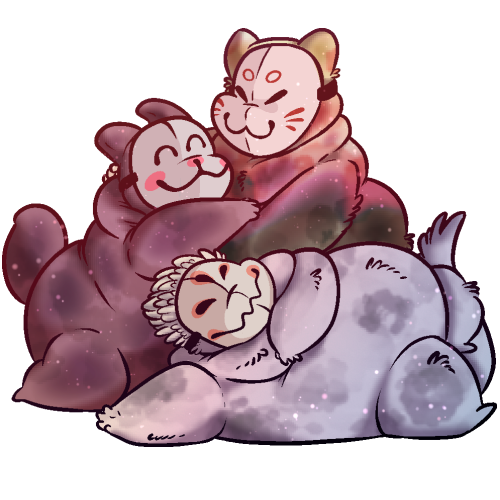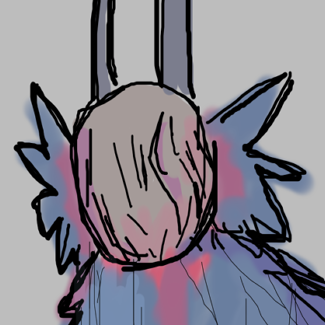[Cosmosdex] The Universal Encyclopedia
[Cosmosdex]
Eidolon
Putty Buddy / Walking Pillow
Eidolon

Art by, Festerday
- Strength-1
- Intelligence-1
- Charisma-6
- Endurance-1
- Agility-1
- Luck-0
Type: Manipulative
Danger Level: Safe
Commonly Infects: Friends and family of host, People who are prone to shows of physical affection
Attack Method: Does not attack, but can carry and spread more aggressive strains.
Summary: Leaves the original host's mind intact, but alters their appearance and behaviour to be more appealing; uses this to get close to people and infect them.
Original Creator: Cacket
Physical Description
Eidola will typically be asymptomatic for between two and five days after being infected while the strain breaks down and converts the host's internal tissues. The strain is not infectious by skin contact at this time; however, bodily fluids will contain the strain and contact of those fluids with anybody else's mucus membranes should be avoided at all costs. At the end of the incubation period, or after seven days at most, all of an eidolon's flesh excluding the nervous system will be a suspension of undifferentiated cells in infectious fluid. Cells removed from the main body will remain alive and can be molded like clay or put back into the eidolon's mass. However, eidolon nervous tissue does not exhibit the same clay-like properties as the rest of the body, instead healing at a normal pace for the base species, and flesh from two different Eidola will not mix.
Eidola appear similar to individuals with large deposits of body fat, in some cases a seemingly impossible amount for species exceptionally low in normal body fat. They have an abnormal amount of hair, fur, or feathers for their base species; eidola arising from naturally naked-skinned species will don soft and padded clothing, sometimes with fur on the outside, to compensate. Feathered eidola cannot fly if it was previously possible, as the flight feathers will gain the same flexibility and softness as down. Any horns, spikes, or sharp edges on an eidolon will be rounded and softened, though not lost entirely. Eidola that previously had a hard shell or carapace, such as that found on contractors, will keep the shell, but it will be much softer, flexible, and silky to the touch, with very reduced but still significant slime production.
All eidola emit a smell similar to that of clothes fresh out of the dryer, combined with faint hints of blood and gasoline. This smell is so specific to eidola that it can be used to make the final judgment in cases in which it is otherwise impossible to tell whether a suspected eidolon is infected or not.
Due to the loss of sensory specialization like visual and olfactory cells, eidola cannot see, smell, or taste, but they can sense heat, touch, and vibration, which allows them to navigate their environment functionally even if they previously relied on one of the senses lost. Many eidola will wear a mask of some sort, as most facial features, especially the eyes and teeth, will no longer be recognizable as such.
Eidola arising from automatons will seek out any available flesh, even meat rations if on a ship, and attach it to their bodies until a suitably thick covering is formed. All inorganic parts will remain and the face will usually have a thin, transparent membrane over it as opposed to the thick flesh covering the rest of the body. They will usually wear clothes or seek out animal pelts to absorb and use as their own fur. However, they will not remove skins that are still attached to bodies, alive or dead.
Behavior
Eidola are not strong or fast; most blows will sink into their flesh without resistance and they have difficulty fighting back. If a fight breaks out, they will choose to retreat to safer ground, even if their previous personality was highly aggressive.
During the incubation period, hosts will greatly increase their food intake to give the infection more tissue to work with. They will also appear to be sick with a common, low-threat disease, symptoms can vary depending on multiple factors such as environment and host species, and will reduce their social contact for the incubation period.
A fully active eidolon will retain the brain, mind and memories of its host, with some alterations caused by hormone imitation to induce differences in behavior. It will become lethargic and slow, but appear to be calmly upbeat in personality and encourage others to sit and relax with it. However, the eidolon strain has no personality or consciousness on its own or in hosts without a nervous system to alter, instead laying in one place and waiting for another living thing to brush against it by mistake.
As this strain does not actively fight or attempt to forcibly infect others, instead relying on its appearance to lure people in, it can be easily contained with a quarantine or simply burning the slime off of surfaces it has touched.
The main threat of eidola is in their ability to carry and spread other, more dangerous strains. These strains will be completely asymptomatic in the carrier, but can be transmitted to others in place of the eidolon strain and become an infection.
Eidola do not have any special preference as far as congregation amongst themselves goes, though they are averse to physical solitude. Multiple eidola can be quarantined in the same area without increasing infection risk, but their cuddling may tempt viewers to join more strongly than one eidolon alone.
Subtypes
None / Unknown.
Special
Soft and Snuggly: Eidola are soft and warm by nature, their appearance and physical texture encouraging others to engage in physical contact. Their infectious fluid is transmitted via skin contact and can spread rapidly in communities that encourage friendly touch.
Trivia
• Eidola have been shown to feel genuine pleasure when held or stroked, even by remote research apparatus or other situations with no chance of spreading the strain. This is believed to be why eidola are sometimes found snuggling each other when there is nobody else to touch or hold.
• Due to the difficulty in navigating their environments, most eidola get to know a particular area well and remain in that area as much as possible, though some absorb and attempt to integrate hardware such as cameras and GPS systems. However, eidola that arose from species that already used heat, vibrations, or touch as their main sense will continue to navigate their environment as they used to and will not need help doing so.
• A group of eidola is called a fort, a snuggle, or a wad, depending on which sources you ask.

